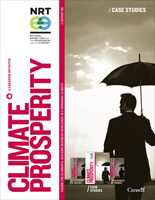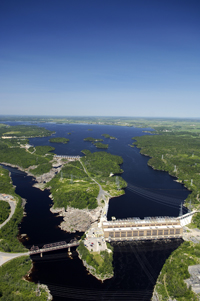Rio Tinto Alcan – Case Study
FACING THE ELEMENTS: Building Business Resilience in a Changing Climate
|
“Demonstrating leadership in climate change strengthens our long term competitiveness.”– Nigel Steward, Vice- President Carbon, Energy and Climate Change, Rio Tinto Alcan |

|
AT A GLANCE // |
Location:Montréal, Québec Industry:Metals and mining (aluminum manufacturing) Employees (2010):22,000 Total revenue (2010):US$60.32 billion |
Key adaptation
|
Adaptation
|
Business BenefitsIdentification of potential risks Potential to gain competitive advantage |
COMPANY OVERVIEW //
MONTRÉAL, QUÉBEC
www.riotintoalcan.com

Rio Tinto Alcan's Isle Maligne
hydro power facility in Canada
(photo credit: Rio Tinto Alcan)
The group operates large-scale, long-life assets on six continents and in 27 countries. This includes a significant presence in Canada, Australia and France. Rio Tinto Alcan currently owns, operates or has an interest in bauxite mines, alumina refineries, aluminum smelters and power generating plants.
ALUMINUM SMELTING IN A CHANGING CLIMATE
Aluminum smelting operations are characterized by large capital investments, long lead-times for new developments, and very tight supply chains. Aluminum smelting covers the entire value chain, from the mining of bauxite, the production of alumina in a refinery, and conversion of alumina into primary metal in a smelter. Because many of the raw materials that go into aluminum smelting are also in demand in other sectors (e.g. cement and steel industries), the market for each input is very tight. At each link in the supply chain, delays or disruptions that prevent a critical material from reaching the next stage in the manufacturing process can be very costly. In the spring of 2011, for example, the aluminum market experienced production disruptions due to flooding of critical ports along the Mississippi River.51
In recent years, lean supply chains have become the standard for mining and smelting operations. Businesses have invested considerable effort in maximizing efficiency by acquiring raw materials and delivering products to the customer with minimal waste. This is achieved by streamlining operations across all links in the supply chain, from procurement and manufacturing to warehousing and transportation. Leanness has brought efficiency and cost savings, but it has also resulted in increased risk of disruption. A survey from the Business Continuity Institute, which analyzed responses from businesses in 35 countries, showed that more than 70% of respondents recorded at least one supply chain disruption in 2010.52 Adverse weather was the main cause of disruption, with 53% of businesses citing this as contributing to recent supply chain disruption.
Supply chain disruptions can cause significant harm to business operations.53 They can raise costs, trigger inventory accumulations, and reduce business market share. A broken or damaged chain puts production and distribution in jeopardy, reducing revenue when goods can’t be manufactured or delivered. Disruptions can also affect credibility with customers, investors, and other stakeholders.
Climate change will cause shifts in both average conditions and the frequency and severity of extreme climate events. These shifts have the potential to affect every aspect of the business supply chain, often in ways that are gradual, diffuse or indirect.
STRATEGIC PLANNING THROUGH A CLIMATE
CHANGE SENSITIVITY FRAMEWORK
Rio Tinto Alcan is developing a climate change sensitivity framework that will help the group to assess the exposure of operations and associated infrastructures to climate change risks. This framework will provide a strategic perspective on the exposure to climate change risks in any geography. The framework will help the group to form a picture of the exposure of potential new sites to current and future climate change impacts across the business model. It presents information about potential climate changes, and draws on the expert knowledge of Rio Tinto Alcan staff to identify a broad range of risks, including (but not limited to) the following:
// Vulnerability of land and marine (sea and river) transport systems, and knock-on risks for supply chains and logistics; problems with marine transport and port facilities due to sea level rise.
// Potential for increased maintenance requirements and degradation of assets that have been designed on the basis of historic climate data and a period of relatively stable weather.
// Potential for downtime and disruption to operations from extreme weather events (natural climatic variability combined with a changing baseline climate) that exceed engineering or operational standards.
//Changes in power generation capacity including variation of production related to increased weather changes.
// Operational risks due to project location and site. Depending on geography, project sites could be exposed to higher temperatures resulting in increased drought risks, or low lying coastal areas at increased risk of flooding. Projects could also be located in pristine ‘frontier’ environments that are uniquely sensitive to changes in climate (e.g. permafrost zones).
// Changes in social performance because of increased competition with local communities for access to climate-sensitive natural resources and changes in socio-economic conditions. For example, water use is at the nexus of different economic activities. Future climate-related impacts on water resources could induce situations of water stress and conflict between users;
// Changes in environment (through changes in habitats, flora and fauna, impacts of discharges and use of natural resources), with consequent risks of failing to meet environmental performance standards.
// Reduced brand equity/reputation of not demonstrably dealing with climate change impacts.
// Political instability as a risk driven by climate change.
// Impacts on site remediation costs.
HANDLING UNCERTAINTY
The climate change sensitivity framework being developed by Rio Tinto Alcan is not intended to predict future climate change by quantifying and reducing the uncertainty of projections. Instead, it accepts that some uncertainties associated with projected climate change are irreducible, and takes account of a range of potential future greenhouse gas emissions scenarios and global climate models. The framework depends on the expert input of Rio Tinto staff, and emphasizes learning from past events. The framework also incorporates a risk matrix that highlights risks that can be addressed as a matter of priority. Instead of a top-down methodology that attempts to foresee the future, Rio Tinto Alcan is building a bottom-up approach that increases the group’s capacity to deal with the unexpected.
BENEFITS AND/OR CHALLENGES
Adapting to the impacts of a changing climate requires a strategic, integrated approach which takes account of moving climatic baselines and changes in social, economic and environmental systems. By developing its climate change sensitivity framework, Rio Tinto Alcan derives the following potential benefits:
// It is realizing opportunity in new geographies – either by identifying risks and opportunities when entering new markets, or through benchmarking against competitors.
// It is identifying new risk dimensions – a by acquiring analysis of both direct and indirect climate change impacts will reveal compound, cross-sectoral, and knock-on issues that can create a domino effect, as impacts in one area create consequential impacts elsewhere within the group’s business model.
// It is developing a competitive edge – through future insights into societal and physical climate sensitivities, and clarity around future asset performance and optimization.
PERSPECTIVES ON GOVERNMENT ROLES
Rio Tinto Alcan has developed a collaborative research partnership with Québec’s Ouranos consortium to better understand the impact of climate change on the Lac Saint-Jean basin in Québec, Canada over the coming years. This partnership, Ouranos’ first with a private-sector organisation, highlights the importance of cooperation between public and private organizations. Ouranos is a joint initiative of the Québec government, Hydro-Québec, Environment Canada, the Université du Québec à Montréal (UQAM), Université Laval, McGill University, and INRS (Institut national de la recherche scientifique) University. Through partnerships like this one, Rio Tinto Alcan underscores its support for government-funded research and data on climate change and its future impacts on business.
NEXT STEPS
The climate change sensitivity framework described in this case study is part of a wider program of climate change initiatives being undertaken by Rio Tinto Alcan. The group is also developing a methodology for taking account of detailed climate risks at the project design and engineering stage. Taken together, these initiatives help the group manage climate change as part of its robust risk management portfolio.
[51] Bonney 2011
[52] Business Continuity Institute 2010
[53] PriceWaterhouseCoopers LLP (UK) 2008








































